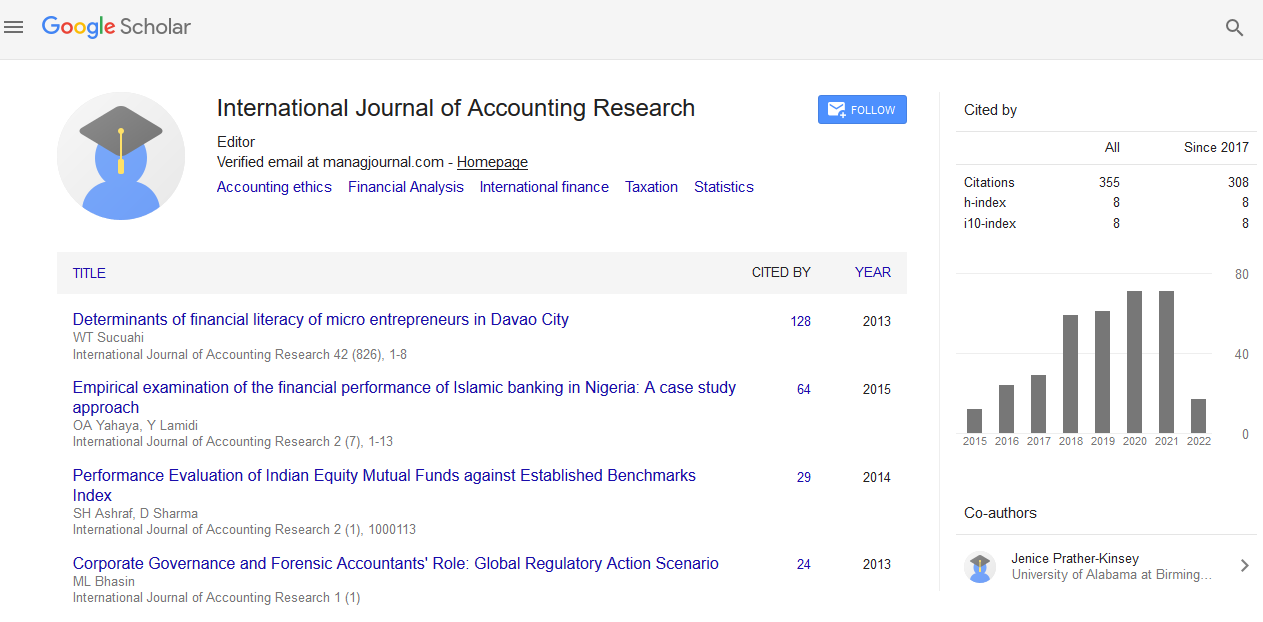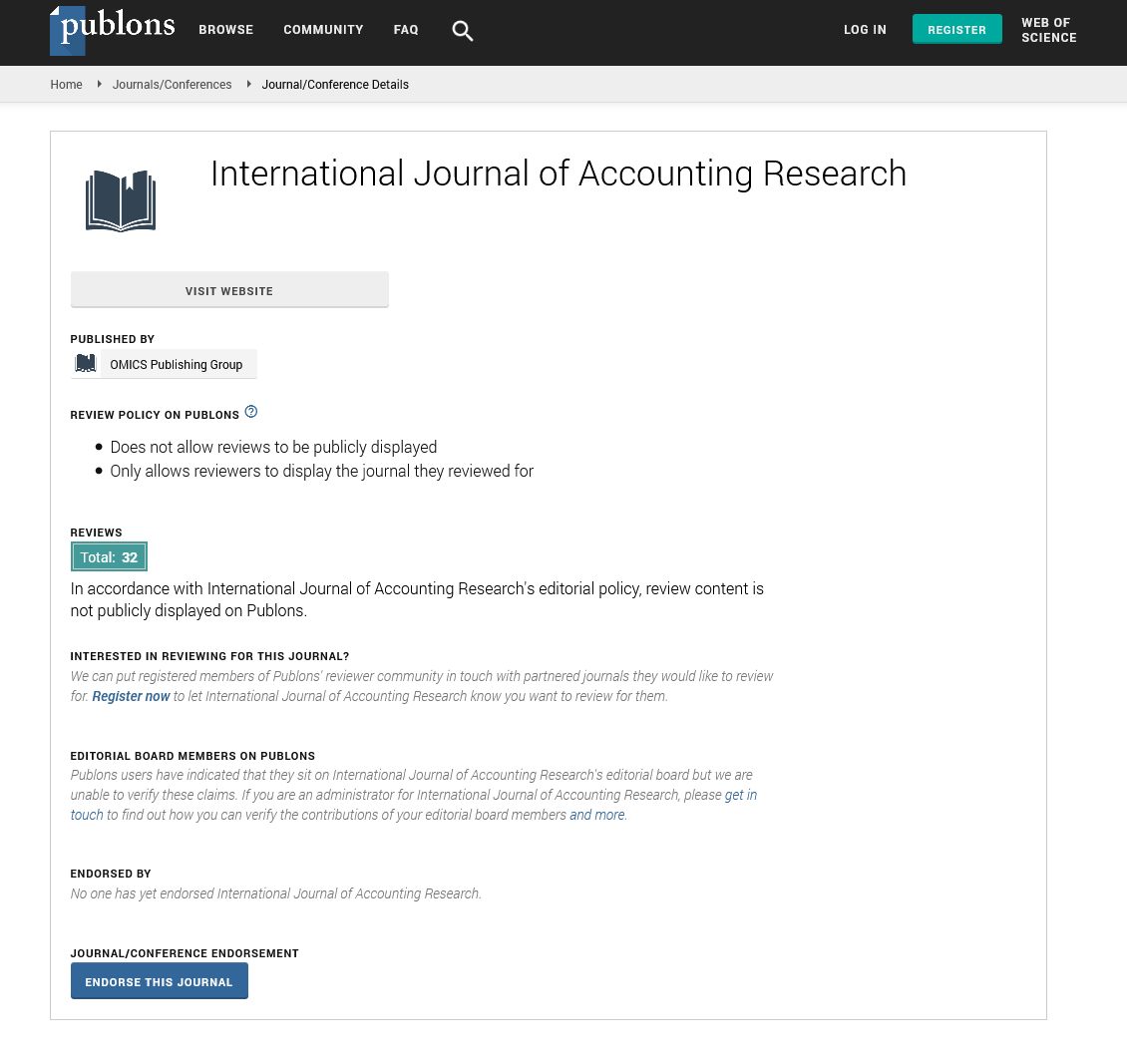Indexed In
- Open J Gate
- RefSeek
- Hamdard University
- EBSCO A-Z
- Scholarsteer
- Publons
- Euro Pub
- Google Scholar
Useful Links
Share This Page
Journal Flyer

Open Access Journals
- Agri and Aquaculture
- Biochemistry
- Bioinformatics & Systems Biology
- Business & Management
- Chemistry
- Clinical Sciences
- Engineering
- Food & Nutrition
- General Science
- Genetics & Molecular Biology
- Immunology & Microbiology
- Medical Sciences
- Neuroscience & Psychology
- Nursing & Health Care
- Pharmaceutical Sciences
Short Communication - (2022) Volume 10, Issue 2
Short Note on Financial Statement
Todd Welch*Received: 01-Feb-2022, Manuscript No. IJAR-22-15960; Editor assigned: 03-Feb-2022, Pre QC No. IJAR-22-15960 (PQ); Reviewed: 17-Feb-2022, QC No. IJAR-22-15960; Revised: 21-Apr-2022, Manuscript No. IJAR-22-15960 (R); Published: 28-Feb-2022, DOI: 10.35248/2472-114X.22.10.261
Description
A financial statement (or financial report) is an official record of the financial activities and position of a business, individual or other entity.
Relevant financial information is presented in a structured and easy to understand form. They typically consist of four basic financial statements with management's discussion and analysis:
• Balance sheet or statement of financial position, statement of assets, liabilities, and equity, ownership of an enterprise.
• The income statement or profit and loss statement (P&L statement), or comprehensive income statement, or income and expense statement reports a company's income, expenses, and profits for a period of time certain period. The profit and loss account provides information about the business's operations. They include revenue and other expenses incurred during the stated period.
• A statement of changes in equity or statement of shareholders' equity, or statement of retained earnings, showing changes in a company's equity over a period of time certain period.
• The statement of cash flows reflects the cash flow activities of an enterprise; especially its operating, investing and financing activities for a given period.
• The statement of comprehensive income includes other comprehensive income that is not taken into account in determining net income.
For large companies, these statements can be complex, with extensive footnotes to financial statement and management discussions and analysis. Notes usually describe each item on the balance sheet, income statement, and cash flow statement in more detail. Financial statement notes are considered an integral part of the financial statements [1].
“The purpose of financial statements is to provide information about a company's financial position and performance that is useful to a wide range of users in making economic decisions.” Financial statements are understandable, relevant, and relevant. It must be reliable and comparable. Reported assets, owners, capital, income and expenses are directly related to the financial position of the organization.
The Financial statements are intended to be understood by readers who "have a reasonable knowledge of business, economics, and accounting and are willing to study information carefully." Financial statements can be used by users for a variety of purposes [2].
Owners and managers need financial statements to make important business decisions that affect ongoing operations. Then perform a financial analysis of these statements to give management a better understanding of the numbers. These statements will also be used as part of management's annual report to shareholders.
Workers also need these reports in the case of unions or when individuals conclude a Collective Bargaining Agreement (CBA) with management to discuss compensation, promotion and ranking [3].
Potential investors use financial statements to assess the feasibility of investing in a company. Financial research is widely used by investors and is prepared by experts (financial analysts) to provide the basis for investment decisions.
Financial institutions (banks and other lenders) use these to provide new working capital to companies or debt certificates (long-term bank loans) to fund expansion and other significant costs. Or bonds etc.).
Laws vary from country to country, but auditing public company financial statements is usually required for investment, financing, and tax purposes. These are usually performed by an independent auditor or auditing company. The results of the audit are summarized in an audit report containing either a nonqualified audit opinion on the financial statements or eligibility for its validity and accuracy. Audit reports on annual financial statements are usually included in the annual report [4,5].
There is a lot of legal liability as to who the auditor is responsible for. Audit reports are usually addressed to current shareholders, so it is widely believed that they have a legal duty of care. However, this may not be the case, as determined by common law case law. In Canada, auditors are only responsible for investors who purchase primary market stock using prospectuses. In the UK, if the auditor knew about future investors and how he would use the information in his account, they would be held liable to future investors. Auditors today tend to include in their reports a disclaimer of liability that discourages reliance on reports by anyone other than the recipient. Responsibility is an important issue. In the United Kingdom, for example, auditors have unlimited liability.
In the United States, there were serious concerns about the accuracy of financial statements, especially in the post-Enron era. Executive Officers (CEO and CFO) are personally responsible for fair financial reporting, which provides the readers of the report with an accurate view of the organization.
Different countries have developed their own accounting standards, making it difficult to compare companies internationally. Several guidelines and rules are used to ensure consistency and comparability between the financial statements of different companies. These guidelines, commonly referred to as Generally Accept Accounting Principles (GAAP), form the basis for the preparation of financial statements, but many companies voluntarily disclose information beyond these requirements doing.
REFERENCES
- Jianu I. Reliability of Financial Information from the Perspective of Benford’s Law. Entropy. 2021;23(5):557.
[Crossref] [Google Scholar] [PubMed]
- Maślach D, Markiewicz J, Warelis A, Krzyżak M. Importance of financial liquidity in hospital management. Epidemiol. Rev. 2019; 73(3):369-81.
[Crossref] [Google Scholar] [PubMed]
- Afriyie SO, Kong Y, Lartey PY, Kaodui L, Bediako IA, Wu W, et al. Financial performance of hospitals: A critical obligation of corporate governance dimensions. The International Journal of Health Planning and Management. 2020;35(6):1468-85.
[Crossref] [Google Scholar] [PubMed]
- Chandra P. Financial management. Tata McGraw-Hill Education; 2011.
[Crossref] [Google Scholar] [PubMed]
- Smith TB, Welch TD. Interpreting Organizational-Level Financial Statements. Nursing Administration Quarterly. 2021; 45(4):353-9.
Citation: Welch T (2022) Short Note on Financial Statement. Int J Account Res. 10:261.
Copyright: © 2022 Welch T. This is an open access article distributed under the terms of the Creative Commons Attribution License, which permits unrestricted use, distribution, and reproduction in any medium, provided the original author and source are credited.


